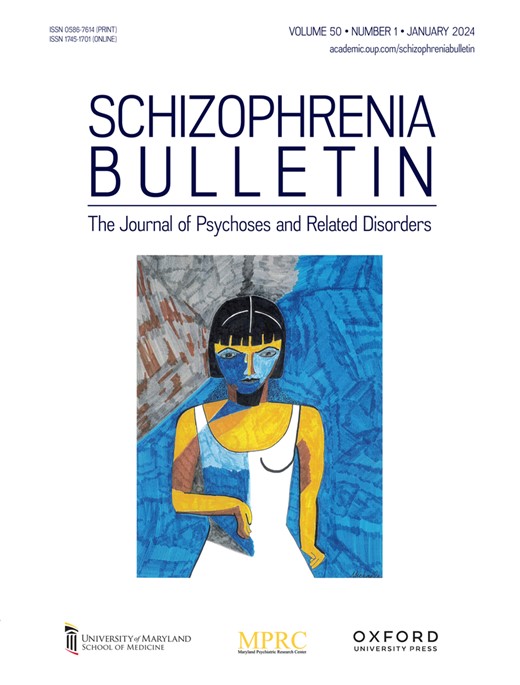Disturbed Functional Connectivity Between Anterior Default Mode and Sensory Processing Regions Is Linked to Peripheral Inflammatory Markers and Psychopathology in Schizophrenia
IF 4.8
1区 医学
Q1 PSYCHIATRY
引用次数: 0
Abstract
Background and Hypothesis Both elevated inflammatory markers and aberrant functional connectivity have been detected in patients with schizophrenia, but there is limited knowledge on the relationship between the two phenomena. Some positive symptoms may arise from external misattribution of self-generated actions mediated by decoupling of the default mode network (DMN) with sensory processing regions. Since the anterior DMN also exhibits bidirectional interaction with the immune system, we hypothesized its decoupling would be associated with elevated inflammatory markers as well as the burden of positive symptomatology. Study Design Resting-state functional magnetic resonance imaging, diffusion tensor imaging (DTI), clinical and laboratory data (serum concentrations of interleukin-6 and C-reactive protein) were collected within a neuroimaging trial on schizophrenia. Neuroimaging data were assessed applying seed-to-voxel and region-of-interest-to-region-of-interest functional connectivity analyses as well as DTI tractography. Associations between neuroimaging and laboratory as well as behavioral data were studied employing regression analyses. Study Results For both inflammatory markers, a consistent pattern of hypo-connectivity emerged between the anterior DMN and different brain regions involved in sensory processing and self-monitoring. The strongest association was detected for the connectivity between the anterior DMN and the right parietal operculum which was not explained by the structural integrity of the respective white matter tract. Finally, this functional connection was correlated both with the burden of positive and negative symptoms. Conclusions Our findings reveal a mechanistically plausible neurobiological link between inflammation and psychopathology in schizophrenia.前默认模式和感觉加工区域之间的功能连接紊乱与精神分裂症的外周炎症标志物和精神病理有关
背景与假设在精神分裂症患者中发现了炎症标志物升高和功能连接异常,但对这两种现象之间的关系知之甚少。一些阳性症状可能是由默认模式网络(DMN)与感觉加工区域解耦介导的自生成行为的外部错误归因引起的。由于前侧DMN也表现出与免疫系统的双向相互作用,我们假设其解耦将与炎症标志物升高以及阳性症状负担有关。研究设计在一项精神分裂症的神经影像学试验中收集静息状态功能磁共振成像、弥散张量成像(DTI)、临床和实验室数据(血清白细胞介素-6和c反应蛋白浓度)。应用种子到体素和感兴趣区域到感兴趣区域的功能连通性分析以及DTI束状图对神经成像数据进行评估。采用回归分析研究了神经影像学与实验室和行为数据之间的关系。研究结果对于这两种炎症标志物,在DMN前部和涉及感觉处理和自我监控的不同大脑区域之间出现了一致的低连通性模式。在DMN前部和右侧顶盖之间的连通性被检测到最强的关联,这不能用各自白质束的结构完整性来解释。最后,这种功能联系与阳性和阴性症状的负担都相关。结论:我们的研究结果揭示了精神分裂症患者炎症和精神病理之间的一种机制上似是而非的神经生物学联系。
本文章由计算机程序翻译,如有差异,请以英文原文为准。
求助全文
约1分钟内获得全文
求助全文
来源期刊

Schizophrenia Bulletin
医学-精神病学
CiteScore
11.40
自引率
6.10%
发文量
163
审稿时长
4-8 weeks
期刊介绍:
Schizophrenia Bulletin seeks to review recent developments and empirically based hypotheses regarding the etiology and treatment of schizophrenia. We view the field as broad and deep, and will publish new knowledge ranging from the molecular basis to social and cultural factors. We will give new emphasis to translational reports which simultaneously highlight basic neurobiological mechanisms and clinical manifestations. Some of the Bulletin content is invited as special features or manuscripts organized as a theme by special guest editors. Most pages of the Bulletin are devoted to unsolicited manuscripts of high quality that report original data or where we can provide a special venue for a major study or workshop report. Supplement issues are sometimes provided for manuscripts reporting from a recent conference.
 求助内容:
求助内容: 应助结果提醒方式:
应助结果提醒方式:


